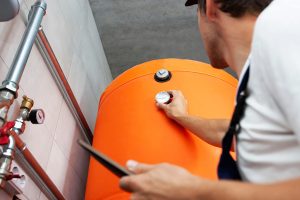How to Install a Heating Oil Tank
Installing a new heating oil tank can be an affordable and easy way to keep your home warm. It can be a big job, but the right instruction and preparation can make it easier.
In this oil tank installation guide, we’ll outline the key considerations for the installation process. Find out what a heating oil tank installation entails below.
Finding the Right Domestic Oil Tank for Your Home
When it comes to heating oil tanks, there are several types to choose from. The type you need will depend on a number of factors. You should consider the size of your home, the level of protection needed, and your budget.
Some of the most common types of oil tanks include:
Integrally Bunded – Integrally bunded tanks have a secondary containment system, known as a ‘bund’. The purpose of the bund is to act as an additional safety feature. The bunded construction also offers a secondary level of protection if the primary containment system leaks.
Double-Skinned – A double-skinned tank has two layers of protection and is more expensive. However, they offer better protection against leaks and can hold more oil than single-skinned tanks.
Single-Skin – A single-skin tank has only one layer of protection. While they are less expensive than other alternatives, single-skin tanks are also more likely to leak than other types. That’s why single-skin tanks are subject to strict regulations and not common anymore.
Underground – As the name suggests, these tanks are suitable for underground placement. They are more expensive than aboveground tanks but have a number of benefits, including being less likely to leak. However, you may need to obtain planning permission.
What is the best heating oil tank?
We recommend choosing an integrally bunded tank. Designed to prevent oil spills and leaks, bunded tanks are the most secure option for your oil. If you would prefer an alternative recommendation, contact us to discuss the best option for you.
Learn more about different oil storage tanks in our guide to heating oil tank types.
The Importance of Correct Domestic Oil Tank Installation
Ensuring correct installation is one of the most important aspects of heating oil tank installation. This is essential for a number of reasons, for example:
To prevent leaks: An oil leak can be extremely costly, not to mention dangerous to both your home and the environment. Professionals carry out a range of checks during an installation to prevent leaks. If you do suspect a leak, it is important to contact a professional immediately.
To ensure proper functioning: Poor tank installation can cause a number of problems, including decreased efficiency and increased risk of breakdown.
To comply with local regulations: In many areas, there are strict regulations surrounding the installation of oil tanks. Failure to comply with these regulations can result in fines or other penalties. Find a full list of regulations and safety requirements on gov.uk.
When choosing a company to install your oil tank, it is important to do your research. Find a company that has a good reputation and the necessary experience. We always refer our customers to local OFTEC-registered engineers when it comes to installation.
Can I Install My Own Heating Oil Tank?
As mentioned above, it is important to execute the installation correctly. Installing your oil tank without the experience and expert knowledge of an OFTEC-registered engineer could lead to serious problems. While it can be tempting to save money with a DIY job, it could end up costing you more in damages.
In short, it’s best to leave oil tank installations to a professional to ensure correct installation.
Contact us to enquire about oil tank installations.
Preparing for Installation
The process of installing a tank is generally not complicated and should not take more than a day or two. However, there are a few things you can do to prepare:
Choose the location – The location of your tank is important for a number of reasons, including safety and compliance with local regulations. We will help you to find the right tank location for your home.
Prepare for the installation – On the day of installation, you should create a clear path for the installers to access your tank. This preparation may involve moving any obstacles out of the way or providing temporary power if necessary.
Where Should I Put My Heating Oil Tank?
When deciding where to put your oil tank, there are a few things you need to take into consideration.
First, you need to make sure that the area is easily accessible for delivery. There should be enough space around it for the delivery driver to manoeuvre. You also need to make sure that the tank is far from any sources of heat or ignition.
There are several fire, water and security guidelines to take into account when choosing the location of an oil tank. These considerations include:
- The location of the tank should be at least 1.8 metres away from the doors or windows of fire-rated buildings.
- Heating oil tanks should also be at least 1.8 metres away from non-fire rated structures such as garden sheds and furniture.
- Heating oil tanks require a suitable concrete or stone base if positioned near water.
Discuss your individual location requirements with a professional to ensure the safest possible position for your premises.
The general recommendation for oil tank replacements is every 10 years. Most oil tanks are steel or plastic and can last for many years when they are well-maintained. However, it is important to have regular tank inspections. During a tank check, an engineer will make sure that your tank is in good condition and not leaking.
Generally, 1,000 litres of oil can last up to one year. However, the amount of heating oil you need will depend on the size of the tank, the efficiency of your oil boiler and the size of your house.
If you are looking to remove an old heating oil tank, it is best to leave it to professionals. Trying to remove it yourself could end up costing you more if something goes wrong.
The cost of a new heating oil tank will vary depending on the size and type you choose. Most range in price from £900 – £1500 and there may be an additional cost for installation.
The installation process doesn’t have to be complicated or expensive. Follow these tips to ensure the correct installation of your oil tank and reduce future problems caused by improper installation.
We hope you found this guide helpful. If you have any questions or concerns, please feel free to contact us.
Read more about our domestic heating oil tank services.





